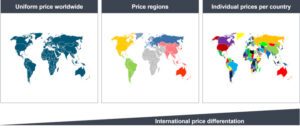Complexity and gray market risks as key challenges for international price management
Increasing internationalization and the associated development of different markets offer great opportunities for companies. At the same time, however, activity on international sales markets also harbors weighty risks and poses complex challenges for international price management.
Complex decisions
To be able to exploit international sales and earnings potential to the fullest, a large number of complex decisions have to be made in the context of price management. These decisions relate to the structure for international price differentiation and the extent of international price differences. In addition, price management also involves issues relating to internal transfer prices and the handling of different currencies and the resulting risks.
Gray market risks
With more pronounced international price differences, gray market risks or imports as well as professional and globally positioned purchasing organizations and structures represent relevant challenges for suppliers. Low barriers and trade barriers between different countries as well as increasing international price transparency make price differentiation more difficult and can even lead to dangerous price and profit erosion. Insufficiently thought-out or careless international price management can therefore become a dangerous risk factor for successful operation on international sales markets – this applies to almost all industries and to manufacturers and retailers alike.
Optimal international price control and setting through analytical approaches and suitable concepts
In the context of optimal international price control, strategic considerations (for example, growth or earnings focus) should first be made with regard to the relevant markets for further consideration. This should be accompanied by a systematic evaluation of different options and possibilities for international price differentiation (for example, country prices or price regions). In order to determine the structure as well as to assess potential price levels, systematic analyses and evaluations of various internal and external factors in relation to the relevant markets must be carried out
These include, for example, the competitive situation and competition, purchasing behavior and purchasing power as well as willingness to pay, cost aspects, legal framework conditions and, above all, the risk of possible gray market risks. Suitable analyses of internal data can also provide important insights into the current extent of international price differentiation or the international price levels of a supplier.

With regard to a concrete design of international price levels, a defined price corridor can represent the optimal solution in many cases. When defining the corridor, both market- and country-specific price-sales functions or optimum price levels and the resulting gray market risks can be considered and taken into account in combination in order to map the optimum from a global supplier perspective. On the one hand, this allows international sales and earnings potential to be exploited in the best possible way and unfavorable effects caused by potential gray market risks to be controlled.
An analytical view of international pricing as well as systematic control are therefore essential – in addition, it may be necessary to embed systems for international price control into already existing price logics. A systematic and analytical approach in conjunction with the application of targeted concepts and tools not only enables the complexity of international pricing to be mastered, but also allows the opportunities in the form of sales and earnings potential to be optimally exploited while simultaneously controlling the risks.
Project examples
Some of the projects we have worked on over the past years can be found here:
- Introduction of a system for international price control at an internationally operating trading company
- Design, simulation and implementation of a performance-based condition system and an international price corridor for a global brand manufacturer in the sanitary industry
- Introduction of price regions and a logic for international price control for the initial business and aftersales business of a globally positioned mechanical engineering company
- Development of a global pricing concept incl. price regions and price corridors for a manufacturer and dealer in the automotive aftermarket
- Redesign and harmonization of international pricing for a global pump manufacturer
- Design and implementation of international price control as well as simulation of possible gray market risks for a leading household appliance manufacturer
Optimize your international pricing and make the most of international sales and earnings potentials
We are always available to discuss your questions and challenges in international pricing and our suitable solutions by telephone or in person.

Gregor Buchwald
Gregor Buchwald is Managing Director of Prof. Roll & Pastuch – Management Consultants. He has over 20 years’ specialist industry knowledge and consulting experience. His focus is on the areas of strategy, pricing and sales. His customers include multi-national companies as well as medium-sized B2B customers. Mr Buchwald has also written numerous publications about strategy, sales and pricing and speaks at numerous events.

Kai Pastuch
Kai Pastuch is Managing Director of Prof. Roll & Pastuch – Management Consultants. Before joining as Managing Partner, he was Director at a leading international strategy and marketing consultancy. As a graduate in business informatics, he also manages our software company nueprice, which specializes in the pricing of spare parts with the product of the same name. Mr. Pastuch has extensive project management experience from numerous projects for large international companies and German medium-sized businesses in the areas of price management, marketing, sales and strategy. In addition to numerous publications in renowned journals and the publication of the reference books Praxishandbuch Preismanagement and Big Deal Management, he is a sought-after moderator and speaker on all aspects of sales and pricing. As a practice-oriented manager, he likes to get personally involved in our projects and contributes his broad experience in workshops and steerings.